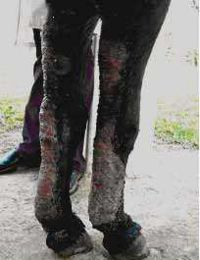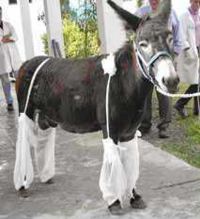Difference between revisions of "Insect Hypersensitivity - Donkey"
(New page: {{review}} ==Insect hypersensitivity== [[Image:Allergic dermatitis donkey.jpg|right|thumb|200px|<small><center>The legs of a donkey showing a severe pruritic allergic dermatitis due to th...) |
m (Protected "Insect Hypersensitivity - Donkey" [edit=sysop:move=sysop]) |
(No difference)
| |
Revision as of 23:48, 16 February 2010
| This article has been peer reviewed but is awaiting expert review. If you would like to help with this, please see more information about expert reviewing. |
Insect hypersensitivity


Insect hypersensitivity occurs in donkeys, but is not often the typical ‘sweet itch’ syndrome seen in horses. In D. Knottenbelt’s experience, many of the cases suffer from sensitivity to biting flies other than Culicoides spp. Nevertheless, many do show a typical distribution and seasonal onset that is indistinguishable from equine ‘sweet itch’.
Clinical signs
Typically the affected donkey shows an intense pruritus that becomes worse when exposed to the causative insects and shows a progressive severity with succeeding years. Self-trauma causes extensive hair loss, dermatitis and variable lichenification and thickening of the skin on the neck and withers regions in particular. The rump and tail head are also affected in many cases.
With increasingly traumatised skin, secondary infection, further fly irritation and exposure to ultraviolet light, the condition can rapidly become very serious in individual animals.
Treatment
Whilst treatment is required in any case that shows signs, it is far better to prevent exposure to the allergen. This may be easier said than done! Most insects do not ‘like’ windy, cold or rainy conditions and so providing these climatic conditions can be a useful way of helping. However, the downside of this is that these conditions are not ideal for donkeys in other respects. Housing during maximal risk periods (e.g. overnight) and ‘turn-out’ at minimal risk periods (e.g. in the heat of the day) can help.
Insect repellents and other synthetic pyrethroids as well as various natural and other insect repellents also help, but in severe cases the only effective way is to separate the donkey from the allergen. All-in-one suits may be practical, but in most cases are not! Severely excoriated skin can be treated with antibiotic/steroid creams. Parenteral medication with corticosteroids such as prednisolone may be the only way of reducing the severity of the inflammation. In D. Knottenbelt’s experience the use of depot steroids such as methylprednisolone actetate is not very useful.
References
- Knottenbelt, D. (2008) Skin disorders In Svendsen, E.D., Duncan, J. and Hadrill, D. (2008) The Professional Handbook of the Donkey, 4th edition, Whittet Books, Chapter 8
|
|